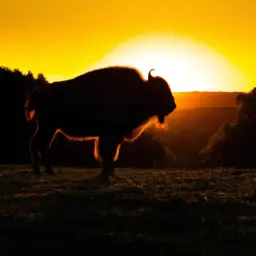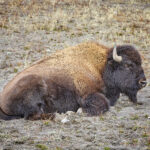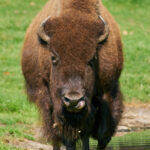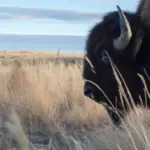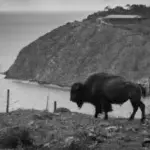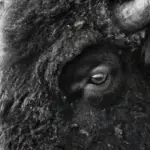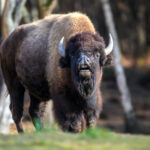Imagine discovering a world where an ancient species of majestic creatures still roam freely. If you’re an adventurer longing to witness the raw beauty of nature, you won’t want to miss the answer to the question: What European country has the highest concentration of bison left? Delve into the captivating world of these incredible animals as we uncover the hidden gem that is home to the largest surviving population in Europe. Prepare to be awestruck as you embark on a journey to this picturesque destination that promises an unforgettable wildlife encounter.
Overview of Bison in Europe
Bison, also known as the European bison or wisent, once roamed freely across the continent of Europe. However, due to human activities and habitat destruction, their population declined drastically, pushing them to the brink of extinction. In recent years, conservation efforts have been made to protect and revive the European bison population. This comprehensive article aims to provide an overview of the history, decline, conservation efforts, distribution, and future of the European bison.
History of Bison in Europe
The European bison has a rich and ancient history on the continent. Fossil records indicate that these majestic creatures have existed in Europe for over 2 million years. They once populated vast areas, including forests, grasslands, and wetlands, making them an integral part of the European ecosystem. Unfortunately, the rise of human civilization led to their decline.
Distinction between American and European Bison
It is important to distinguish between the American bison and the European bison. While they belong to the same family and share some characteristics, there are notable differences between the two species. European bison are larger and have longer legs, a hump over their shoulders, and a more prominent beard. These characteristics make them well-suited to the dense forests and colder climates of Europe.
State of European Bison in the 21st Century
The European bison faced a critical situation in the 20th century, with only a few individuals left in captivity. Thanks to dedicated conservation efforts, their numbers have gradually increased, and the species has been saved from the brink of extinction. However, the European bison still faces challenges, such as fragmented habitats and genetic bottlenecks. Despite these challenges, the current state of European bison offers hope for their future survival.
Understanding the Decline of Bison
To fully appreciate the efforts being made to conserve and protect the European bison, it is essential to understand the factors that contributed to their decline.
Factors contributing to Bison decline
The decline of European bison can be attributed to a combination of factors. Habitat loss due to deforestation and conversion of land for agriculture significantly impacted the bison’s natural habitat. In addition, human interference, such as hunting and predator control, played a detrimental role in reducing their populations. Disease outbreaks, competition from livestock, and lack of suitable migration corridors further exacerbated their decline.
Impact of hunting on Bison population
Historically, bison hunting has been a major factor in the decline of European bison populations. In the past, these magnificent creatures were hunted for their meat, hides, and horns. The unregulated and excessive hunting by humans resulted in a rapid decline in their numbers, pushing them to the brink of extinction.
Influence of human’s intervention on Bison habitats
Human intervention and the alteration of natural habitats significantly affected the survival of European bison. The conversion of forests into agricultural land, the growth of human settlements, and the construction of infrastructure disrupted their habitats and limited their access to food and water sources. These changes had a profound impact on the bison’s ability to thrive in their natural environment.
Conservation Efforts for the European Bison
Recognizing the importance of protecting this iconic species, various institutions and organizations have dedicated themselves to the conservation of European bison.
European Institutions dedicated to Bison conservation
Several European institutions, such as the European Bison Conservation Center (EBCC) and the European Wildlife Bank, have been established to coordinate and support conservation efforts for the European bison. These institutions work in collaboration with national organizations and conservation initiatives to promote the recovery and sustainable management of the bison population.
Breeding and Reintroduction Programs for European Bison
Breeding programs have played a vital role in the conservation of European bison. These programs focus on maintaining a genetically diverse captive population, which can serve as a source for reintroductions into the wild. Reintroduction programs aim to establish new populations in carefully selected areas, ensuring that the bison can thrive and contribute to the ecosystem’s balance.
Success Stories of Bison Conservation
There have been notable success stories in the conservation of European bison. Countries like Poland, Belarus, and Russia have witnessed significant recoveries of their bison populations through dedicated conservation efforts. These success stories highlight the importance of collaboration between governments, conservation organizations, and local communities in protecting and restoring this magnificent species.
Current Distribution of European Bison
The European bison, once on the brink of extinction, now has a more promising distribution across various countries in Europe.
Countries with known Bison Populations
Poland, with its vast forested areas and conservation efforts, has the highest concentration of European bison in the wild. Other countries that have successfully reintroduced bison populations include Belarus, Russia, Lithuania, and Ukraine. These countries have implemented robust conservation strategies and have witnessed the positive results of their efforts.
Wild vs. Captive Populations of Bison
While the European bison’s recovery in the wild is commendable, there are still significant populations maintained in captivity. Captive populations serve as a safeguard against potential threats, ensuring the survival of the species in case of any unforeseen events. These captive populations also contribute to genetic diversity and act as potential sources for reintroductions in the future.
Poland: Europe’s Bison Haven
Poland has played a crucial role in the conservation of European bison, earning its reputation as Europe’s Bison Haven.
Presence of Bison in Poland
Poland is home to the largest population of European bison in the wild, with over 3,000 individuals roaming its forests and protected areas. These bison, known as “Bialowieza bison,” reside primarily in the Bialowieza Forest, a UNESCO World Heritage Site and one of the last and largest remaining parts of primeval lowland forest in Europe.
Efforts for Bison preservation in Poland
Poland has been at the forefront of bison conservation efforts, with various initiatives in place to protect and promote the survival of this iconic species. The Bialowieza National Park and other protected areas provide crucial habitats and protection for the bison. Additionally, collaborative efforts between the government, NGOs, and local communities ensure the continuation of conservation programs and the sustainable coexistence of bison with humans.
Challenges faced in Poland concerning Bison preservation
Despite the success in conserving and expanding the bison population in Poland, there are ongoing challenges that need to be addressed. Fragmentation of habitats, potential disease outbreaks, and maintaining genetic diversity are some of the key challenges faced in ensuring the long-term survival of the European bison. Continued efforts and collaboration are crucial to overcome these challenges and secure a thriving future for the bison in Poland.
Belarus: A Significant Bison Habitat
Belarus is another European country that has made remarkable progress in restoring the bison population and preserving their natural habitat.
Belarus Bison Population
Belarus is home to a significant population of European bison, with around 800 individuals in the wild. The Belovezhskaya Pushcha National Park, spanning the border between Poland and Belarus, provides a critical habitat for the bison. The park’s vast forests, marshes, and meadows offer ideal conditions for the bison to roam freely and thrive.
Conservation Steps in Belarus
Belarus has implemented rigorous conservation measures to protect the European bison. The establishment of protected areas, such as the Belovezhskaya Pushcha National Park, has been instrumental in preserving the bison’s natural habitat. Strict regulations regarding hunting and illegal activities within these areas ensure the safety and well-being of the bison population.
Belarus and its unique Bison habitat
Belarus boasts a unique bison habitat that extends beyond the confines of national parks. The country’s extensive network of forests, wetlands, and nature reserves provides additional opportunities for the bison to find suitable habitats and expand their range. This diverse landscape makes Belarus a significant player in the conservation efforts to protect and restore the European bison population.
Other European Countries with Bison
Apart from Poland and Belarus, several other European countries have made notable contributions to bison conservation.
Russia’s Bison population
Russia is home to a growing population of European bison, with several areas within the country serving as important habitats. The Oksky and Prioksky reserves are active in bison conservation, working towards the recovery and expansion of the bison population. These reserves provide protected areas and critical resources for the bison to thrive.
The state of Bison in Lithuania
Lithuania has also witnessed positive developments in bison conservation. The Žuvintas Biosphere Reserve, located in southwestern Lithuania, has successfully reintroduced the bison into its vast wetland habitat. This reserve demonstrates the potential for effective conservation efforts in creating suitable environments for the bison.
Ukraine’s efforts towards Bison conservation
Ukraine has exhibited dedication to the conservation of European bison, with initiatives focused on establishing viable bison populations. The Carpathian Mountains, in particular, provide excellent habitat for these magnificent creatures. The Carpathian Biosphere Reserve in Ukraine is actively involved in bison restoration and has seen encouraging results.
European Bison in Zoos and Reserves
Apart from the populations existing in the wild, European bison also find refuge in zoos and reserves across Europe.
Places to see Bison in Europe
Zoos and wildlife reserves provide an opportunity for people to observe and engage with European bison up close. Many European countries, including Germany, Sweden, and the Netherlands, have zoos and wildlife parks that display bison and educate visitors about their conservation significance.
Role of Zoos and Reserves in Bison conservation
Zoos and reserves play a crucial role in the conservation of European bison. They contribute to captive breeding programs, genetic diversity, and research and education. Additionally, these institutions raise awareness about the importance of conserving this iconic species and provide a link between humans and the natural world.
The Role of Bison in Ecosystems
European bison play a vital role in maintaining the balance and biodiversity of ecosystems.
How Bison contribute to biodiversity
Bison are considered a keystone species, meaning their presence has a profound impact on the structure and functioning of ecosystems. Their grazing behavior helps maintain open landscapes, promoting the growth of diverse plant species. By creating clearings and disturbance areas, bison contribute to the habitat diversity, benefiting a wide range of plant and animal species.
Impact of Bison on vegetation and other species
Bison’s grazing patterns influence the vegetation composition and structure of their habitats, allowing for the growth of various plants. Their trampling activity helps create bare ground patches, which serve as crucial microhabitats for plants and invertebrates. Additionally, the bison’s dust bathing behavior contributes to the dispersion of seeds and the creation of favorable conditions for vegetation growth.
Which European country has the highest concentration of bison?
Bialowieza Forest in Poland is known for being the habitat of bison. This ancient woodland is home to the largest population of European bison, making it the European country with the highest concentration of these magnificent creatures. The forest’s protected status allows the bison to thrive in their natural habitat.
The Future of European Bison
The future of European bison depends on continued conservation efforts, sustainable coexistence with humans, and addressing the challenges they face.
Predictions for Bison population trends
Given the remarkable progress made in conserving and restoring the European bison population, it is expected that their numbers will continue to rise in the coming years. With ongoing conservation initiatives, reintroduction programs, and collaboration among various countries and organizations, the future for European bison looks promising.
Continuing conservation efforts
Conservation efforts must continue to address the challenges faced by European bison. This includes the preservation and expansion of suitable habitats, genetic diversity management, disease monitoring, and ensuring the involvement of local communities in conservation initiatives. By addressing these factors, the long-term survival of the European bison can be secured.
The importance of sustainable coexistence with Bison
As the European bison population expands, sustainable coexistence with humans becomes crucial. Balancing conservation goals with human activities, such as agriculture and infrastructure development, is essential to ensure the continued survival and well-being of both people and bison. Education and awareness programs play a vital role in fostering understanding and support for the conservation of this iconic species.
In conclusion, European bison have endured significant challenges over the centuries. However, through dedicated conservation efforts, their populations have gradually recovered, offering hope for their continued survival. Recognizing the importance of preserving their habitats, maintaining genetic diversity, and promoting sustainable coexistence, Europe is embracing the task of ensuring a thriving future for the European bison. By working together and continuing conservation efforts, we can secure the legacy of these majestic creatures for generations to come.

